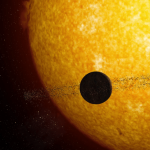Satellite swarms may outshine the night sky’s natural constellations0
- From Around the Web, Space
- September 24, 2021
“Mega-constellations” from those satellites will be visible to the naked eye, simulations suggest

“Mega-constellations” from those satellites will be visible to the naked eye, simulations suggest

NASA is about to announce its next generation of Earth-observing satellites. As soon as this month, it will lay out preliminary plans for a multibillion-dollar set of missions that will launch later this decade. This “Earth system observatory,” as NASA calls it, will offer insights into two long-standing wild cards of climate change—clouds and aerosols—while providing new details about the temperatures and chemistry of the planet’s changing surface. The satellite fleets also mark a revival for NASA’s earth science, which has languished over the past decade compared with exploration of Mars and other planets.

The only radio antenna that can command the 43-year-old spacecraft has been offline since March as it gets new hardware, but work is on track to wrap up in February.

The US military’s newest branch has launched its first satellite, despite a short delay in the countdown.

Hypergiant Industries has clients like NASA, Shell, and Booz Allen. It says it can use machine learning from satellite imagery to detect anomalies.

The future of space exploration might be through tiny satellites that can fit in the palm of your hand.

Thursday, January 30th 2020, 9:45 am – This near-miss highlights the worries about Kessler Syndrome and the future safety of spacecraft and space travel

SpaceX launched 60 mini satellites Monday, the second batch of an orbiting network meant to provide global internet coverage.

If aliens love satellites as much as we do, we might be able to spot them